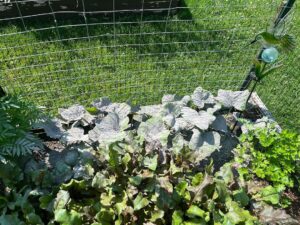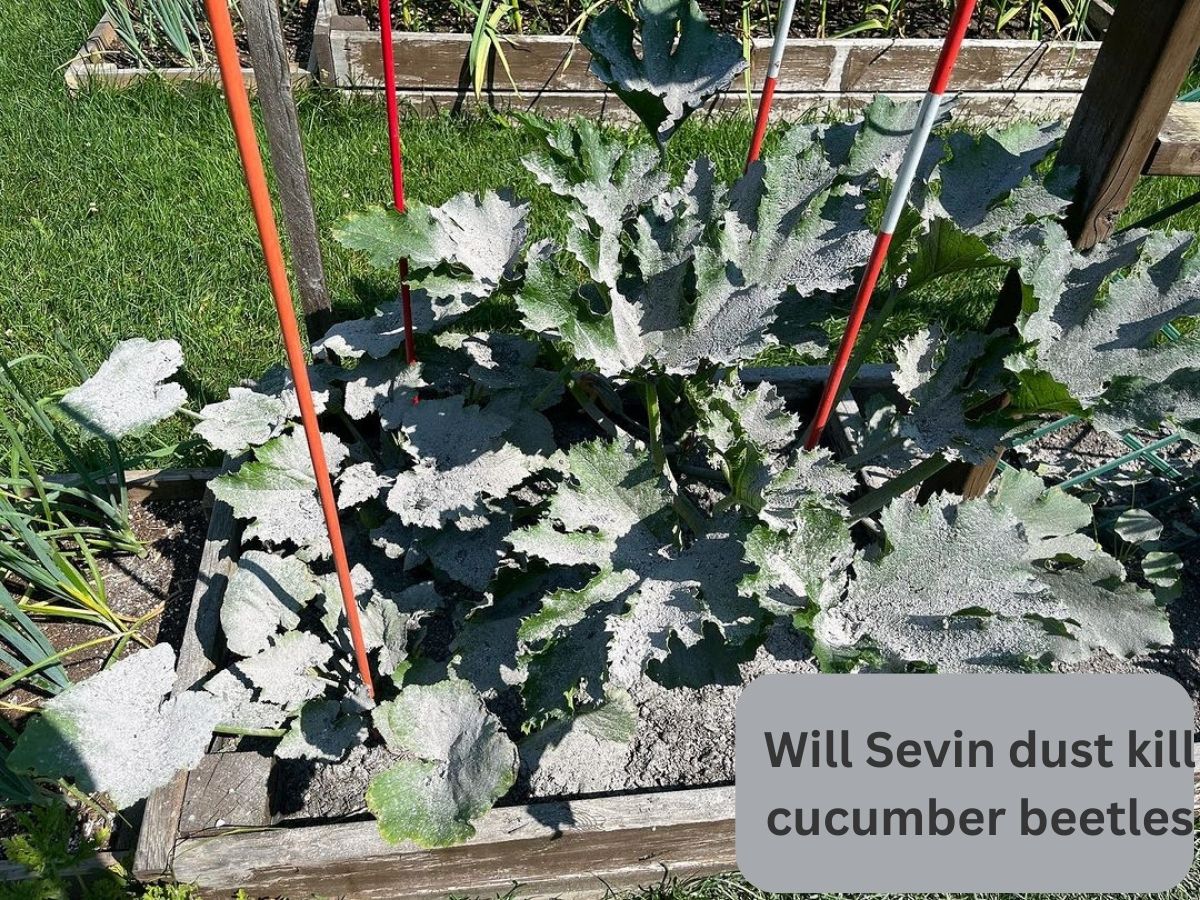Will Sevin Dust kill cucumber beetles? If you’ve ever faced the frustration of cucumber beetle infestations wreaking havoc on your precious cucumber plants, you’re not alone. These persistent pests can quickly turn a thriving garden into an eyesore.
If you’ve ever dealt with cucumber beetles wreaking havoc on your precious cucumber plants, you know just how frustrating and destructive these tiny pests can be.
Sevin Dust, a popular insecticide, has long been hailed as a go-to solution for various garden pests. Its broad-spectrum control and reputation for effectiveness make it a tempting choice for battling the cucumber beetle invasion. But does it truly live up to the hype?
The short answer is yes, Sevin Dust can indeed help control cucumber beetles. This insecticide contains carbaryl, a powerful chemical compound known for its ability to eliminate a wide range of garden pests, including the cucumber beetle. When applied properly, Sevin Dust creates a protective barrier, ensuring these destructive bugs meet their untimely demise.
Below, we’ll dive into the effectiveness of Sevin Dust in combating cucumber beetles. We’ll explore its active ingredient, application methods, and safety precautions, and even discuss alternative options for those seeking organic solutions. So, let’s equip ourselves with the knowledge to protect our cucumber plants and bid farewell to cucumber beetle woes once and for all.
The Damaging Effects of Cucumber Beetles
Cucumber beetles may be small in size, but their impact on cucumber plants can be significant. To effectively combat these pests, it’s essential to understand their appearance, behavior, and life cycle, as well as the potential damage they can cause.
Appearance:
Cucumber beetles typically measure around a quarter-inch in length and come in two common varieties: the striped cucumber beetle and the spotted cucumber beetle. Striped cucumber beetles have yellow bodies with three black stripes running along their backs, while spotted cucumber beetles have a yellowish-green body with twelve black spots.
Behavior and Life Cycle:
These beetles emerge in early spring and start feeding on cucumber plants, flowers, and foliage. They lay eggs near the base of plants or in the soil, where the larvae hatch and begin feeding on plant roots. The larvae then pupate and emerge as adult beetles, continuing the cycle.
Potential Damage:
Cucumber beetles pose a threat to cucumber plants in multiple ways. They feed on leaves, stems, and flowers, causing visible damage and weakening the overall plant health. They can also transmit bacterial wilt, a disease that can lead to the death of cucumber plants. Additionally, cucumber beetles can interfere with pollination, resulting in reduced fruit production.
Understanding the appearance, behavior, and potential damage caused by cucumber beetles is crucial for implementing effective control measures. In the following sections, we will explore how Sevin Dust can help eliminate these pests and safeguard your cucumber plants.
Will Sevin dust kill cucumber beetles
When it comes to tackling cucumber beetles and other garden pests, Sevin Dust has emerged as a popular choice among gardeners and farmers alike. Let’s take a closer look at this renowned insecticide, its active ingredient, and how it effectively controls pests, including cucumber beetles.
Overview of Sevin Dust:
Sevin Dust is a widely recognized brand of insecticide that comes in a powdered form. It contains the active ingredient carbaryl, which has proven to be highly effective in combating a broad spectrum of garden pests. Sevin Dust is easily accessible and commonly used in both residential and agricultural settings.
Active Ingredient and Mode of Action:
The active ingredient in Sevin Dust, carbaryl, belongs to a class of chemicals called carbamates. Carbaryl works by interfering with the nervous system of pests, causing paralysis and ultimately leading to their demise. It acts as a contact insecticide, meaning it must come into direct contact with the target pest to be effective.

Effectiveness in Killing Cucumber Beetles:
Sevin Dust has demonstrated remarkable effectiveness in controlling cucumber beetles. When applied correctly, it can swiftly eliminate these pests, preventing further damage to cucumber plants. Its contact-killing properties make it particularly useful against adult beetles, which are the most destructive stage of the cucumber beetle life cycle.
By harnessing the power of carbaryl, Sevin Dust has established itself as a reliable weapon in the battle against cucumber beetles. In the next section, we will delve into the proper usage and application techniques to maximize the effectiveness of Sevin Dust in eradicating these persistent pests.
How to Use Sevin Dust to Control Cucumber Beetles
To effectively control cucumber beetles and protect your precious cucumber plants, it’s crucial to understand the proper application of Sevin Dust. Follow these step-by-step instructions, along with essential safety precautions, to ensure successful usage:
Step-by-Step Application:
- Wear protective clothing, including gloves, long sleeves, and pants, to avoid direct contact with the product.
- Choose a calm day for the application to prevent the wind from dispersing the dust in unintended areas.
- Ensure the cucumber plants are dry before applying Sevin Dust.
- Using a handheld duster or shaker, evenly distribute the Sevin Dust on the foliage, stems, and flowers of the cucumber plants.
- Pay special attention to the undersides of leaves, as cucumber beetles tend to hide there.
- Avoid excessive dusting, as it may cause runoff or harm beneficial insects.
- Repeat the application as necessary, following the recommended guidelines for the specific Sevin Dust product.
Safety Precautions:
- Always read and follow the instructions and safety guidelines provided on the Sevin Dust product label.
- Store Sevin Dust in a secure location away from children and pets.
- Avoid inhaling the dust or getting it in your eyes or mouth.
- Wash your hands thoroughly after handling Sevin Dust.
- Dispose of any unused products or empty containers responsibly, following local regulations.
Ideal Timing and Frequency:
- Apply Sevin Dust as soon as you notice cucumber beetles or signs of damage on the plants.
- For best results, apply Sevin Dust in the early morning or late afternoon when the beetles are most active.
- Repeat the application according to the recommended interval on the product label or as needed, especially during periods of heavy infestation.
By adhering to these guidelines, you can ensure the effective use of Sevin Dust in controlling cucumber beetles and safeguarding your cucumber plants. In the next section, we will explore alternative methods and organic solutions for managing these pests, providing you with a range of options to choose from.

Other Methods for Managing Cucumber Beetles
While Sevin Dust is a powerful tool for controlling cucumber beetles, it’s always good to have alternative methods at your disposal. Here are some additional approaches you can consider for managing these persistent pests:
Cultural Practices:
- Crop Rotation: Rotate your cucumber plants annually to different areas of your garden to disrupt the life cycle of cucumber beetles.
- Row Covers: Use lightweight row covers to physically block cucumber beetles from reaching your plants while still allowing sunlight and moisture to penetrate.
Organic Solutions:
- Neem Oil: Apply neem oil to your cucumber plants, focusing on the leaves and stems. Neem oil acts as both a repellent and an insecticide, deterring cucumber beetles from feeding and interfering with their reproduction.
- Homemade Sprays: Create homemade sprays using ingredients such as garlic, onion, or hot pepper mixed with water. These natural deterrents can help keep cucumber beetles at bay.
Beneficial Insects:
- Encourage Beneficials: Attract and introduce beneficial insects to your garden, such as ladybugs and lacewings, which feed on cucumber beetle eggs and larvae, helping to control their population.
Handpicking:
Regularly inspect your cucumber plants and manually remove cucumber beetles by hand. Drop them into a bucket of soapy water to prevent them from returning.
Companion Planting:
Intercrop your cucumber plants with companion plants that naturally repel cucumber beetles, such as radishes, tansy, or catnip. This can help deter the pests from infesting your cucumber plants.
Trap Crops:
Plant trap crops, such as squash or melons, near your cucumber plants, to attract cucumber beetles away from your main crop. Monitor and manage these trap crops accordingly.
Beneficial Nematodes:
Consider using beneficial nematodes, microscopic worms, that target and control the larvae of cucumber beetles in the soil. These can be applied to the soil according to the package instructions.
Natural Predators
Attract natural predators of cucumber beetles, such as birds or toads, to your garden by providing nesting boxes, bird feeders, or water sources.
Remember, combining different methods and implementing an integrated pest management (IPM) approach can enhance your success in managing cucumber beetles. By diversifying your strategies, you can create an environment that is less conducive to cucumber beetle infestations.
By incorporating these additional methods into your cucumber beetle management strategy, you can increase your chances of effectively controlling and reducing the impact of these pests on your cucumber plants.
Will Sevin Dust Kill Cucumber Beetles FAQs?
Can Sevin Dust harm other beneficial insects?
Sevin Dust, when used as directed, primarily targets and affects the insects it comes into direct contact with, including pests like cucumber beetles. However, it’s important to note that Sevin Dust is a broad-spectrum insecticide and can potentially harm beneficial insects as well.
Be cautious when applying Sevin Dust and avoid spraying it directly on flowers or where beneficial insects are actively present. To preserve beneficial insect populations, consider using targeted application methods, such as applying the dust selectively or using alternative pest control methods that have minimal impact on beneficial insects.
Is Sevin Dust safe to use on edible crops like cucumbers?
Yes, Sevin Dust is labeled for use on edible crops, including cucumbers. However, it is crucial to follow the instructions provided on the product label. Pay close attention to the pre-harvest interval, which indicates the number of days that must pass between the last application of Sevin Dust and when it is safe to harvest the cucumbers.
This ensures any residue on the plants has sufficiently degraded to levels deemed safe for consumption. Always adhere to the recommended application rates and safety precautions when using Sevin Dust on edible crops.
How long does it take for Sevin Dust to kill cucumber beetles?
Sevin Dust acts as a contact insecticide, meaning it must come into direct contact with cucumber beetles to be effective. Once the beetles come into contact with the dust, they will be affected within a relatively short period, usually within hours or a few days.
However, the exact time it takes for Sevin Dust to kill cucumber beetles may vary depending on factors such as the beetle’s size, susceptibility, and the amount of dust applied. It’s important to be patient and allow sufficient time for the product to take effect before assessing its effectiveness.
Can I use Sevin Dust indoors or only outdoors?
Sevin Dust is primarily intended for outdoor use. It is designed to be applied to plants and foliage in garden settings, including vegetable gardens. When using Sevin Dust, it’s important to ensure proper ventilation and avoid applying the dust in enclosed or confined indoor spaces.
If you encounter pest issues indoors, consider using alternative pest control methods specifically labeled for indoor use to ensure the safety and well-being of occupants. Always read and follow the product label instructions for the appropriate usage and application guidelines.
Conclusion
When it comes to combating cucumber beetles and protecting your cucumber plants, Sevin Dust proves to be a reliable and effective solution. Its active ingredient, carbaryl, targets and eliminates cucumber beetles, preventing further damage.
By following proper application techniques and safety precautions, you can maximize the effectiveness of Sevin Dust while ensuring the safety of your plants and the environment. Additionally, alternative methods such as cultural practices, organic solutions, and beneficial insects provide additional options for managing cucumber beetles.
Remember to consider factors like the impact on beneficial insects and the safety of edible crops when using Sevin Dust. By implementing a well-rounded approach and incorporating these various methods, you can successfully control cucumber beetles and enjoy healthy cucumber harvests.
